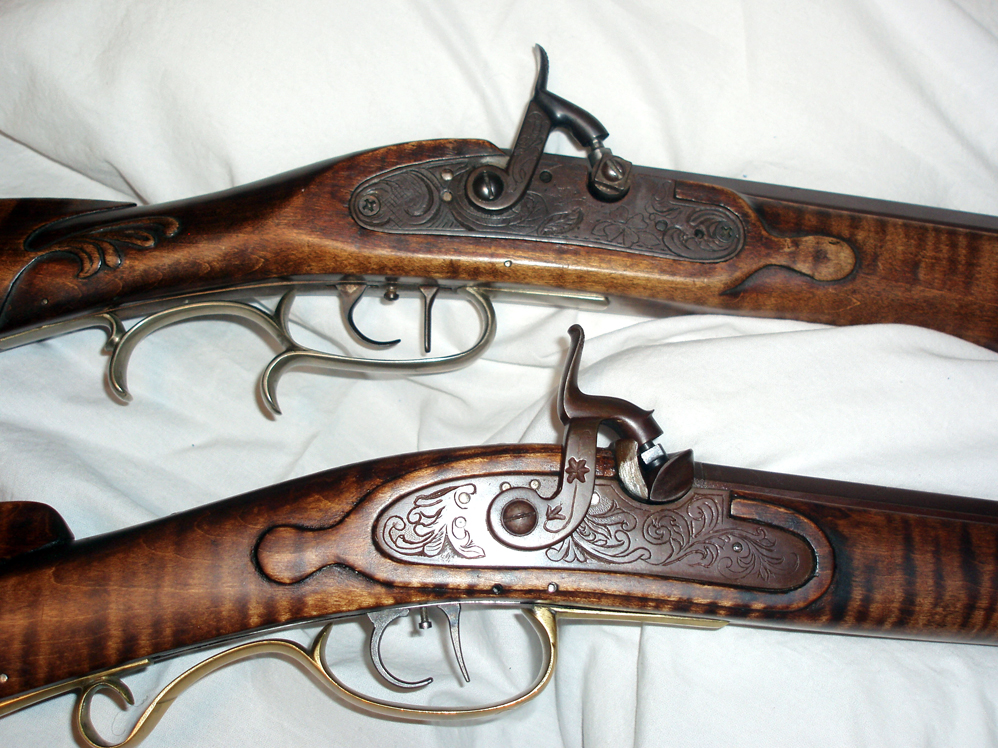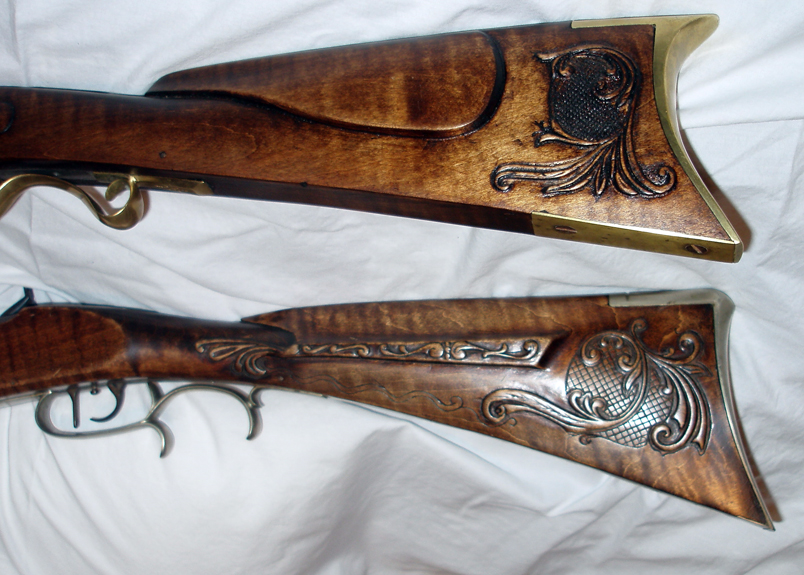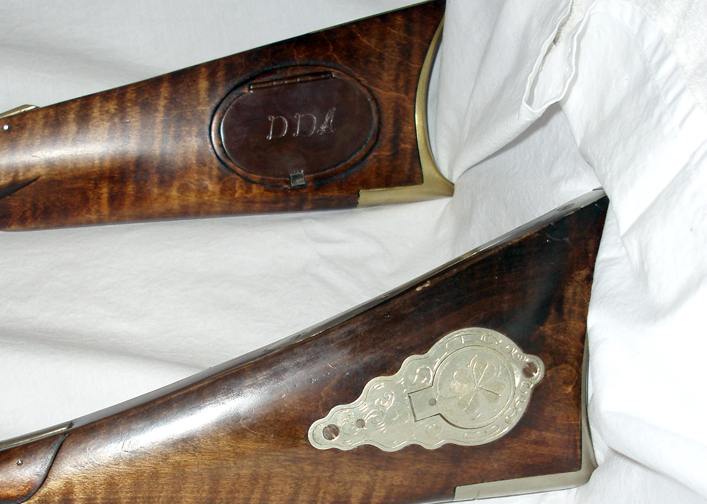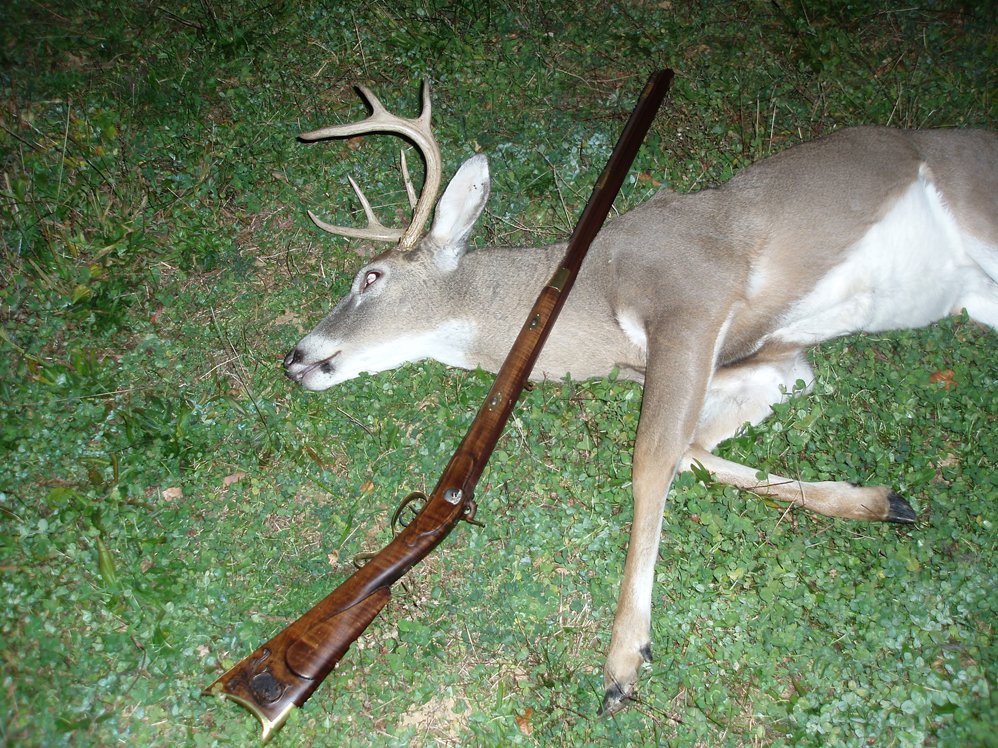MUZZLELOADING MEMORIES
By
George Angell
I have always enjoyed the printed word about the use of the more primitive ways of hunting, no matter what animal is being pursued. I read a recent article which made me sit down and ponder this issue, and I put my thoughts on paper, something I rarely do.
I built my first .40 caliber long barrel Kentucky-style rifle in 1968. I built another .40 cal a year or so later. By then, I figured I needed something that would be legal for deer, a minimum of .45 caliber, so I opted for a .54 cal and ended up making a “Hawken” style rifle with a walnut stock.

 By that time, the primitive bug had its fangs buried deep
within me. This was about the time the movie Jeremiah Johnson was
a big hit. A little while after I
finished my first .54 cal, I got to figuring again: I needed another .54 cal. I bought a 2 ¼ in. x 10 in. by 10 ft. curly
maple board to get a stock blank out of it
to build a full stock rifle. I wanted
this one to be real special. I personally built the lock and double set
trigger assembly for this one as I had with the very first .54. I bought the German silver investment
cast butt plate, trigger guard and cap box from Dixie Gun Works. I made all of the other inlays
from German silver pieces I scrounged from other sources. I even used a silver spoon for the toe
cap. I did my first detailed raised and
incised carving on this stock, along with the engraving on the metal
parts. After building this gun, I ended
up finishing some T/C kits and other build-from-scratch guns
that other “builders” just didn’t have the time or ability to complete. The only pay I received was the
experiences I gained.
By that time, the primitive bug had its fangs buried deep
within me. This was about the time the movie Jeremiah Johnson was
a big hit. A little while after I
finished my first .54 cal, I got to figuring again: I needed another .54 cal. I bought a 2 ¼ in. x 10 in. by 10 ft. curly
maple board to get a stock blank out of it
to build a full stock rifle. I wanted
this one to be real special. I personally built the lock and double set
trigger assembly for this one as I had with the very first .54. I bought the German silver investment
cast butt plate, trigger guard and cap box from Dixie Gun Works. I made all of the other inlays
from German silver pieces I scrounged from other sources. I even used a silver spoon for the toe
cap. I did my first detailed raised and
incised carving on this stock, along with the engraving on the metal
parts. After building this gun, I ended
up finishing some T/C kits and other build-from-scratch guns
that other “builders” just didn’t have the time or ability to complete. The only pay I received was the
experiences I gained.

In early 2009, my wife decided it was time for her to
have one of these primitive style rifles to use rather than her modern
Knight inline .50 cal that she had been using for deer. I thought this was a good idea, so after many
hours of studying and thinking about things, I ordered from the
I began work on my wife’s rifle in March and worked on it
through the summer whenever there was time found between
working on our food plots. We also took
a 3-week vacation in the fall to sightsee and chase the elusive antelope in
 early muzzleloader deer
season was coming up fast, so I had to get on the stick and get my wife’s rifle completed. I finally wrapped it up on the Wednesday
before the season opener on Saturday. I loaded the firearm with 100gr of
FFFg GOEX with a 250gr R.E.A.L. bullet. I set up a 2 ft. piece of cardboard with a 1 ½ x 3 in. black oval at 45 yards. I called my wife to come and give it a
shot. She set up and tripped the
trigger. The rifle fired and smoke
filled the air. I looked at the target
but didn’t see any hole! She missed the whole piece of cardboard!! However, as I walked to the target, trying to see any evidence of contact, I
discovered a hole—3/4 inch below the top edge of the black oval!!! And I had the nerve to think my
wife had completely missed the target!
early muzzleloader deer
season was coming up fast, so I had to get on the stick and get my wife’s rifle completed. I finally wrapped it up on the Wednesday
before the season opener on Saturday. I loaded the firearm with 100gr of
FFFg GOEX with a 250gr R.E.A.L. bullet. I set up a 2 ft. piece of cardboard with a 1 ½ x 3 in. black oval at 45 yards. I called my wife to come and give it a
shot. She set up and tripped the
trigger. The rifle fired and smoke
filled the air. I looked at the target
but didn’t see any hole! She missed the whole piece of cardboard!! However, as I walked to the target, trying to see any evidence of contact, I
discovered a hole—3/4 inch below the top edge of the black oval!!! And I had the nerve to think my
wife had completely missed the target!
I had used the same procedure setting the fixed sights on this gun that I had used on the .54 cal rifles I had built in the past. I had measured with calipers, the bottom of the rear “V” and the top of the front blade and had taken a WAG at what the distance should be. It worked!! What a great surprise—I really couldn’t believe it!! (I developed a pulled muscle in my right shoulder from patting myself on the back.)
My wife hunted on opening day of the early muzzle loading season with a brand new gun that still smelled of the fresh stain and oil finish. No shot opportunity was offered on opening day. Her regular job as an ER doctor kept her from hunting Monday through Thursday of that first week, but she hunted daily through the early and late muzzleloader seasons. Sad to say, she never had an opportunity to shoot.
Fast forward to the 2010 early muzzleloader season. My wife hunted alone the first three days of the first week, but we decided to hunt together on Thursday afternoon. We climbed into our new 4x8x15 foot tall box stand which overlooks a clover and small burnet plot. We had an exciting evening, seeing some small does and button bucks. Soon a mature doe and a spike buck surfaced. The spike started chasing the little does and buttons all over the clover patch as if he owned the place. As the evening was ending, I stuck my head out of the window in front of me and began to bleat long and loud at the little buck. He never could figure out where the sound was coming from, but he walked under the stand and into the woods behind us. We gave it another five minutes and decided it was time to leave the area. We made our guns safe, put them in their cases and prepared to get down from the stand. My wife took one last look at the food plot and exclaimed, “There’s a deer; I think it’s a doe.” I looked out and could make out the light colored hair inside its ears and gradually determined that there were antlers present that went out past his ears. “It’s a buck!” She immediately retrieved her gun and prepared to take a shot; however, there was not enough light to make a safe and ethical shot, even though legal time remained. I think bleating at the spike buck had raised the larger buck’s curiosity and he had come to check things out.
My wife was unable to hunt that weekend, but I went back to the same stand the next day. It was a rain-threatening day. I sat and watched through the light mist and occasional snow shower as the same visitors returned to nibble on the clover. The same small spike showed up, but wasn’t as frisky as the night before. I was using my full stock .54 cal that I had built some 40 years ago (which lets you know I’m not still wet behind the ears). Now, I don’t get in a real big rush when I’m hunting. I do not cap my gun until I’m ready to shoot. I’ve done that since the time when I was carrying my first .54, capped and half-cocked, when the hammer snagged on a limb in some thick stuff and the gun went off. That was enough to change my ways!
Shortly after 5 pm, a large doe came out of the white pines at the edge of the clover plot at about 32 yards out. I watched her pick the small burnet out of the plot as she made her way down the edge, over the ridge and out of sight. Shortly after she disappeared, I looked back at the spot from which she had come and an antlered buck stepped into view. (We try to shoot only bucks that have anantler spread at least as wide as the outside of their ears. This buck made the grade!) He stepped into the plot, nibbling at the burnet plants just as the doe had done. With plenty of shooting light left and seeing he had a good eight points, I prepared to take the shot. I eased the gun barrel out of the window, pulled the hammer back to full cock, reached over on a little shelf and picked up one of the three caps lying there. I did not take my eyes off the buck as I was putting the cap on the nipple. I lined up the sights on the deer’s shoulder and tripped the trigger. The cap didn’t pop. I reset the double set triggers and hammer, discovering that the cap was not even on the nipple or stuck in the hammer. I got a second cap and made sure it was on the nipple and once again lined up the sights onthe buck.
This time when I pulled the trigger everything worked properly. The deer took off, angled down into the pines and disappeared. The thought never entered my mind that I might have missed him until I got to where the deer had been standing and I couldn’t find any blood or hair. This was NOT the first time I’d seen such a situation, so I began to follow the line he took by where he had kicked up the pine needles as he fled. I picked up a bit of blood at about 40 yards. He was headed down a very steep hill. Even though darkness had set in, I continued to track him by flashlight for another 30 yards or so, finding more and more sign. Indeed I had not missed. I didn’t think I had missed him, but there’s always some apprehension when you don’t see anything at the spot where he was shot. I found my buck piled up against a 3 inch sapling.
I smelled that pungent rut aroma before I ever saw him. Being as steep as the hill was, there was no way I could pull him back up to the food plot, so I dragged him down another 50 yards to a skid trail. I left him there, returned to the clover plot, picked up my gear and rode back to the house in the Mule. I got on my tractor (with a front end loader) and returned to my deer where I easily rolled him into the bucket, returned to the house and called in my kill to the VA Dept. of Game and Inland Fisheries. I then called my wife to tell her of my success. She was thrilled for me but I could sense a little disappointment in her voice—I had taken the buck that we had seen and she had wanted. I had really wanted her to take a nice buck with her .45 cal and now I was feeling a little guilty for having killed the buck. (I must confess: once that killer instinct takes over in me, I have to let it play out!)
My wife had to work the following four days and was unable to pursue her deer. I stayed near the house so that no disturbance of the deer and other wildlife would cause her to not get a chance at another deer when she returned home. By Friday afternoon, she was more than ready to get out and hunt. She decided to hunt from another stand, a tripod stand tucked in some white pines overlooking an 8-acre area of food plots and warm season native grasses. I left her with a good luck kiss (as always) and I drove the Mule across the valley to another stand. About 5:25 pm, I heard a shot, but didn’t think it had come from her stand, so I just sat and waited until dark, hoping to get a shot at another nice deer.
Heading back to pick up my wife, I rounded a curve in the trail and there she was, holding a flashlight and waving me down. When I stopped, she jumped in beside me. I asked if she had seen anything and she smugly said that she’d shot a “big ol’ doe.” NOT what I wanted to hear! (We already had plenty of meat in the freezer: we had two antelope from our 2010 WY trip, a big doe that I had taken during archery season and the buck from the week before.) I had wanted her to take only a nice buck, but I dared not say a thing. As we approached her stand, she directed me to pull the Mule over into the clover field. I kept turning the Mule to the right and then the lights fell onto her “big ol’ doe”—one that was sporting a nice 8 point rack!!! (I won’t mention that her 8 pointer was bigger and better than the one I had taken the week before.) Hugs and kisses and congratulations and smiles were all around. She had indeed shot her first branch antlered buck with the gun I had built especially for her.

Now I needed to hear the story. Here goes: She had heard a buck rubbing on the staghorn sumac in the edge of a pine stand about 30 yards to her right, but couldn’t see him for the pine limbs surrounding the stand. When she first saw the buck, he was directly in front of her stand, about 15 feet away. She let him walk up into the clover and when he was in good position, she was ready. AsUncle Ted would say: “Cocked, locked and ready to rock”!!!. She pulled the trigger and when the smoke cleared, the deer had dropped where he had last stood. She had dropped him in his tracks!!! First shot at a deer with this gun and he’s down! WOW!!! From the muzzle of her rifle to the deer was less than 40 feet! If you’re lucky enough to get a deer that close, you’re lucky enough!
I backed the Mule up close to the top of the road bank near where the buck lay. We dragged him right into the back of the Mule, drove back to the house where I worked to get him ready for dressing while she went to check in her kill. The next call she made was to her Daddy. He’s the one responsible for her love of the outdoors. Oh, he can walk on water, too! She has told me so and I’m obliged to believe everything she tells me!
One question that is often asked: “Why do we do hunt with these primitive firearms?” There really is no simple answer, but there is nothing I know of that can give a hunter any more satisfaction or pleasure than building your own hunting equipment (be it firearms, knives or bows and arrows) and putting them to the test and succeeding. And, I guess, when you do that for family or someone you love, it makes it even sweeter.
| HUNTING | GUNS | DOGS |
| FISHING & BOATING | TRIP REPORTS | MISCELLANEOUS ESSAYS |
| CONTRIBUTIONS FROM OTHER WRITERS|
| RECIPES |POLITICS |